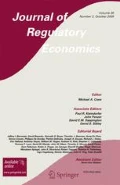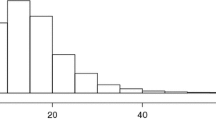Abstract
This paper shows that increasing block rate pricing schedules usually applied by water utilities can reduce the efficiency and equity levels. To do this, we first present a two step method to estimate the demand and to recover the distribution of consumer tastes when increasing block rate pricing is used. We show that in this case the tariff induces a pooling equilibrium and customers with different taste parameters will be observed to choose the same consumption level. Second, we show that a two-part tariff that neither reduces the revenue for the firm nor increases the aggregate level of water consumption increases the welfare and equity levels in relation to an increasing block rates schedule.
Similar content being viewed by others
References
Agthe, D. E., and R. B. Billings. 1987. “Equity, Price Elasticity, and Household Income Under Increasing Block Rates for Water.” American Journal of Economics and Sociology 46: 273-286.
Brown, S. B., and D. Sibley (Eds). 1986. The Theory of Public Utility Pricing. Cambridge: Cambridge University Press.
Crandall, R. W., and L. Waverman. 1995. Talk is Cheap. The Promise of Regulatory Reform in North American Telecommunications. Washington: Brookings.
Dimopoulos, D. 1981. “Pricing Schemes for Regulated Enterprises and their Welfare Implications in the Case of Electricity.” Bell Journal of Economics 12(1): 185–200.
Gabel, D., and M. D. Kennet. 1993. “Pricing of Telecommunications Services.” Review of Industrial Organization 8: 1–14.
Ivaldi, M., and D. Martimort. 1994. “Competition Under Nonlinear Pricing.” Annales D'Economie et De Statistique 34: 71–114.
Mercer, L., and W. Morgan. 1985. “Conservation Using a Rate of Return Rule: Some Examples From California Municipal Water Departments.” Water Resources Res. 21(7): 927–933.
Mitchell, B. M. 1978. “Optimal Pricing of Local Telephone Service Nonuniform Prices.” American Economic Review 68: 517–537.
OECD. 1999. The Price of Water. Trends in OECD Countries. Paris: OECD.
Petrin, A. 1998. “Two Essays in Applied Microeconomics. Minivans and Chile.” Ph.D. dissertation, University of Michigan.
Read, R. C., and A. C. Cressie. 1988. Goodness-of-Fit Statistics for Discrete Multivariate Data. Springer-Verlag.
Renzetti, S. 1992. “Evaluating the Welfare Effects of Reforming Municipal Water Prices.” Journal Environmental Economics and Management 22: 147–163.
Rochet J-C., and P. Choné. 1998. “Ironing, Sweeping, and Multidimensional Screening.” Econometrica 66(4): 783–826.
Wilson, R. 1993. Nonlinear Pricing. New York: Oxford University Press.
Author information
Authors and Affiliations
Rights and permissions
About this article
Cite this article
Castro-Rodríguez, F., María Da-Rocha, J. & Delicado, P. Desperately Seeking θ's: Estimating the Distribution of Consumers Under Increasing Block Rates. Journal of Regulatory Economics 22, 29–58 (2002). https://doi.org/10.1023/A:1019951702523
Issue Date:
DOI: https://doi.org/10.1023/A:1019951702523




